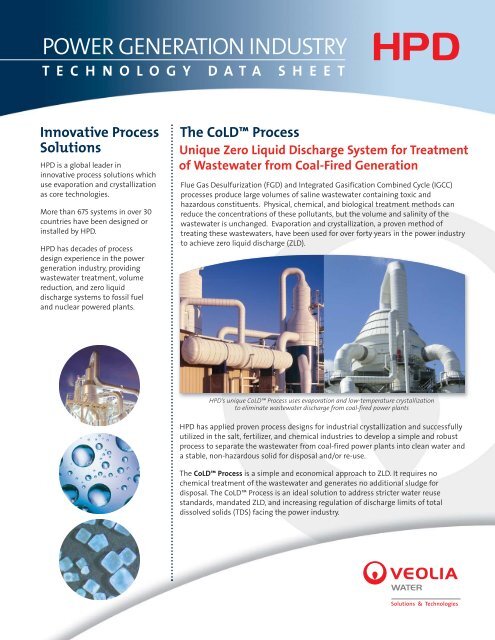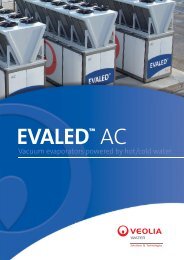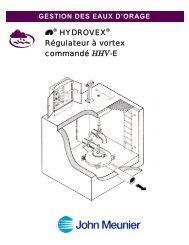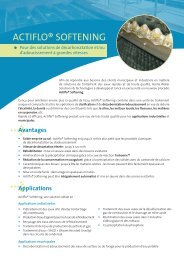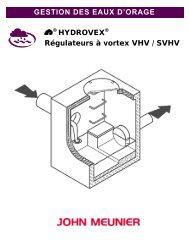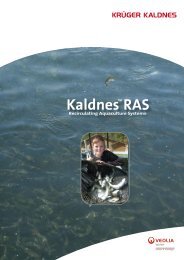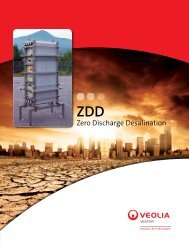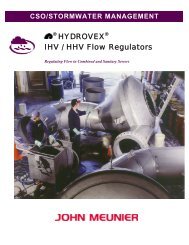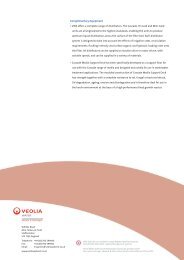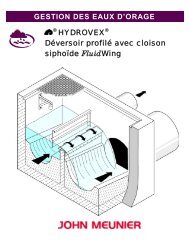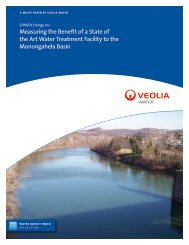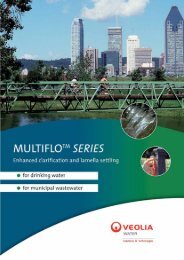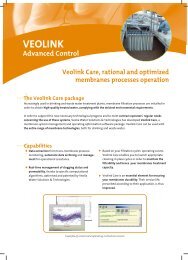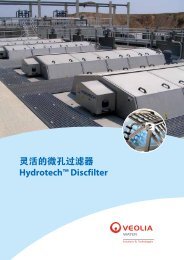HPD PG COLDPROC TDS 5-24:Layout 1 - Veolia Water Solutions ...
HPD PG COLDPROC TDS 5-24:Layout 1 - Veolia Water Solutions ...
HPD PG COLDPROC TDS 5-24:Layout 1 - Veolia Water Solutions ...
Create successful ePaper yourself
Turn your PDF publications into a flip-book with our unique Google optimized e-Paper software.
POWER GENERATION INDUSTRY<br />
T E C H N O L O G Y D A T A S H E E T<br />
Innovative Process<br />
<strong>Solutions</strong><br />
<strong>HPD</strong> is a global leader in<br />
innovative process solutions which<br />
use evaporation and crystallization<br />
as core technologies.<br />
More than 675 systems in over 30<br />
countries have been designed or<br />
installed by <strong>HPD</strong>.<br />
<strong>HPD</strong> has decades of process<br />
design experience in the power<br />
generation industry, providing<br />
wastewater treatment, volume<br />
reduction, and zero liquid<br />
discharge systems to fossil fuel<br />
and nuclear powered plants.<br />
The CoLD Process<br />
Unique Zero Liquid Discharge System for Treatment<br />
of Wastewater from Coal-Fired Generation<br />
Flue Gas Desulfurization (FGD) and Integrated Gasification Combined Cycle (IGCC)<br />
processes produce large volumes of saline wastewater containing toxic and<br />
hazardous constituents. Physical, chemical, and biological treatment methods can<br />
reduce the concentrations of these pollutants, but the volume and salinity of the<br />
wastewater is unchanged. Evaporation and crystallization, a proven method of<br />
treating these wastewaters, have been used for over forty years in the power industry<br />
to achieve zero liquid discharge (ZLD).<br />
<strong>HPD</strong>'s unique CoLD Process uses evaporation and low-temperature crystallization<br />
to eliminate wastewater discharge from coal-fired power plants<br />
<strong>HPD</strong> has applied proven process designs for industrial crystallization and successfully<br />
utilized in the salt, fertilizer, and chemical industries to develop a simple and robust<br />
process to separate the wastewater from coal-fired power plants into clean water and<br />
a stable, non-hazardous solid for disposal and/or re-use.<br />
The CoLD Process is a simple and economical approach to ZLD. It requires no<br />
chemical treatment of the wastewater and generates no additional sludge for<br />
disposal. The CoLD Process is an ideal solution to address stricter water reuse<br />
standards, mandated ZLD, and increasing regulation of discharge limits of total<br />
dissolved solids (<strong>TDS</strong>) facing the power industry.
POWER GENERATION INDUSTRY<br />
T E C H N O L O G Y D A T A S H E E T<br />
Coal-Fired Wastewater Chemistry<br />
Wet Limestone FGD Purge<br />
IGCC Process Wastewater<br />
Wastewater from wet limestone scrubbing contains toxins<br />
and hazardous constituents such as metals, mercury, and<br />
selenium. It is composed mainly of chloride salts of calcium<br />
and magnesium, and is saturated in calcium sulfate.<br />
IGCC wastewater is comprised of toxic and corrosive<br />
components such as chlorides, ammonia, organic<br />
acids, cyanides, sulfides, and heavy metals including<br />
mercury and selenium.<br />
Chemicals<br />
<strong>Water</strong> for Reuse<br />
Energy<br />
Wastewater<br />
Pre-Treatment<br />
Evaporation &<br />
Crystallization<br />
Separation<br />
Drying<br />
CoLD Process<br />
Sludge<br />
Solids<br />
Solids<br />
The CoLD Process reduces both capital and operating costs by eliminating pre-treatment and final drying steps required for<br />
conventional thermal processes. The CoLD Process produces clean water for re-use and a stable solid for disposal.<br />
Limitations of Current Treatment Methods<br />
Conventional thermal processes for FGD and IGCC waste streams require clarification<br />
and extensive pre-treatment of the wastewater with lime, soda ash, caustic, and<br />
other chemicals to replace the calcium, magnesium, and ammonium ions in the<br />
wastewater with sodium ions in order to produce a crystalline solid to achieve ZLD.<br />
In some cases, a final drying step is necessary to produce a stable solid suitable for<br />
disposal. Pre-treatment equipment includes chemical feed/storage facilities, solids<br />
settling or filtration equipment, and sludge dewatering equipment.<br />
These additional facilities increase the footprint of the ZLD system as well as the<br />
capital costs and overall maintenance. The logistics of unloading, storing, and<br />
preparing chemicals and dewatering and transporting sludge for disposal<br />
substantially increase the OPEX.<br />
The CoLD Process however, is operated at low temperature. The chemistries of FGD<br />
and IGCC wastewaters favor the formation of many hydrates and double salts which<br />
precipitate at low concentrations as the temperature of the solution is lowered.<br />
When concentrating the waste stream at low temperature, dissolved solids will<br />
crystallize at relatively low concentration, without the need for chemical<br />
pretreatment and resulting sludge production.<br />
Benefits of the<br />
CoLD Process<br />
• Achieves Zero Liquid<br />
Discharge (ZLD) on difficult<br />
coal-fired wastewaters<br />
• Lowest CAPEX and OPEX<br />
• No chemical pre-treatment or<br />
sludge production<br />
• Produces clean water for<br />
reuse and stable solids for<br />
disposal<br />
• Simple, robust process with<br />
high reliability and availability<br />
• Operating experience in other<br />
industries<br />
USA<br />
23563 W. Main Street, IL Route 126<br />
Plainfield, IL 60544<br />
Tel.: 815-609-2000<br />
Fax: 815-609-2044<br />
SPAIN<br />
Avenida de Neguri, 9 - 1˚<br />
48992 Getxo<br />
Tel.: +34 94 491 40 92<br />
Fax: +34 41 491 11 40<br />
www.hpdsystems.com<br />
<strong>HPD</strong>.info@veoliawater.com<br />
<strong>HPD</strong>-<strong>TDS</strong>-CoLD-0510


